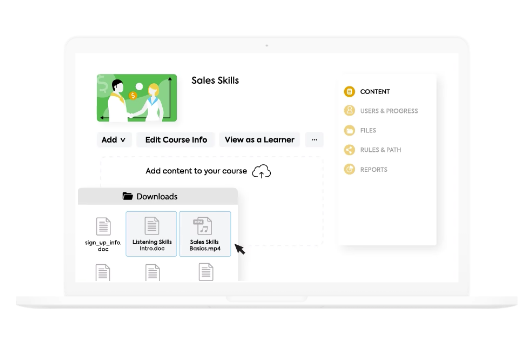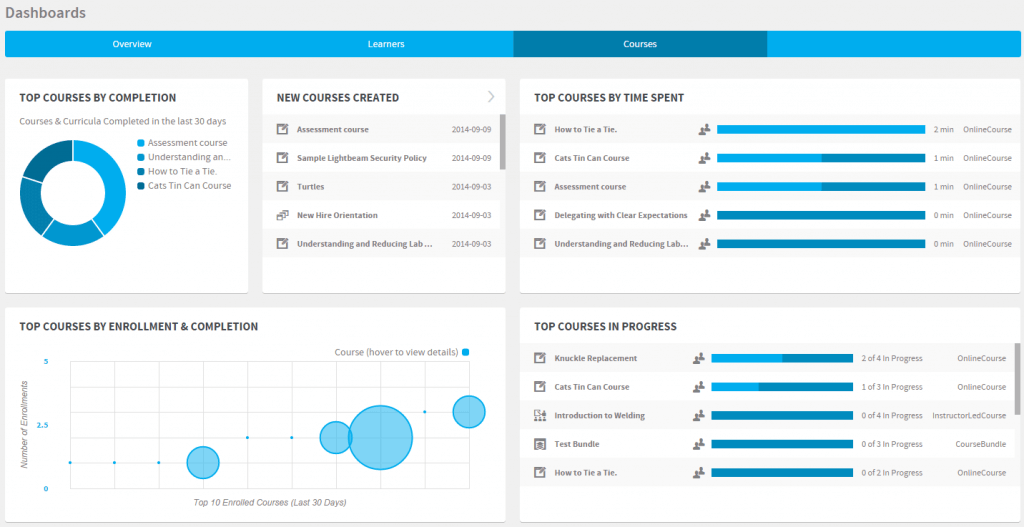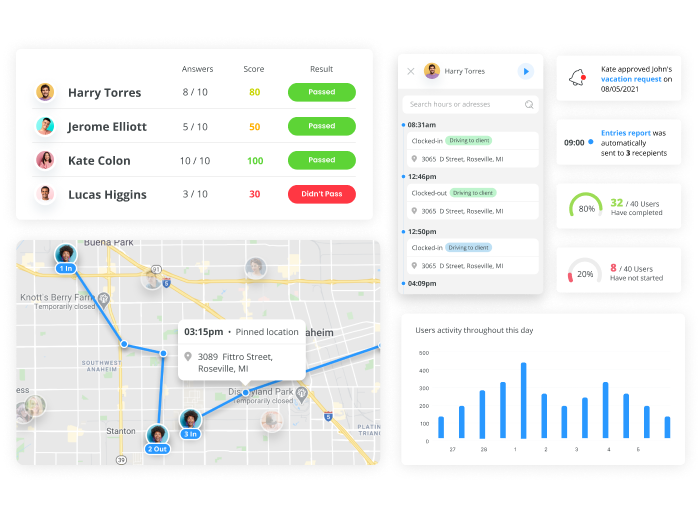
Think back to your countless hours spent playing The Sims. Your focused attention, fingers clicking and guiding your characters, nurturing them to acquire the right skills, fostering their growth, and steering them to thrive. Now, imagine your employees as those characters - just as complex, just as dynamic, and far more real.
These aren't mere pixels on a screen, they're individuals whose skills demand continuous nurturing and improvement. Each employee is a pivotal piece of your organization's puzzle, their productivity paramount to your success. Staying ahead in this fast-paced corporate world often feels like a high-stakes game, and you, the manager, must be the master strategist.
In this endeavor, your most powerful ally is the right employee training software. Like a masterfully crafted game plan, this technology equips your teams with the right knowledge, fine-tuning their skills and ensuring that your business strategies are precisely aligned. The stakes are high, the competition fierce, but the right tools can turn your game of chance into a blueprint for success.
Join us as we delve into the world of employee training software, unraveling its importance, exploring the features to look out for, and revealing our top picks for the ultimate tools that can transform your employees - and your organization - from good to exceptional.
Importance of Employee Training in Organizations
Employee training isn’t just a corporate buzzword—it's the lifeblood that drives the growth and productivity of any organization. Research by IBM showed that 71% of CEOs recognize human capital as a leading source of sustained economic value, ranking it above products, customer relationships, and brands. That's some food for thought.
To tap into this value, organizations need to deliver the right skills to the right people at the right time. This is where top-notch IT training, enablement, and engagement step in. Investing in these areas helps companies reduce attrition and safeguard the substantial investment that hiring represents.
Cultivating a skilled workforce through a dedicated learning solution has tangible, far-reaching benefits. It reaches all corners of an organization, from sales and marketing to customer service and support, and boosts employee performance in many areas. Companies using learning technology see a whopping 16% increase in customer satisfaction and a 35% reduction in time spent rummaging for sales content.
And the financial implications? Unmistakable. With skill levels directly linked to business value, well-trained teams contribute an annual saving of $70,000 and a productivity boost of 10%. Plus, a hefty HR managers vouch for the role of training in talent retention. In essence, investing in employee training isn't just good for business, it's essential for survival in today's competitive corporate landscape.
Key Features to Consider in Employee Training Software
Choosing the perfect employee training software can be quite the mission. It's a game-changer for your business, but only if it fits like a glove. Here are some key features to consider:
1. User-Friendly Interface and Intuitive Design
A well-designed interface helps ensure your team gets the most from the software—and from their training.
Think about it—if your team members struggle to navigate the platform, they're more likely to disengage from the learning process. For instance, a complex login process or convoluted menus can be enough to deter even the most enthusiastic learners.
On the other hand, software with a user-friendly interface, logical navigation, and a clean, visually appealing design makes for a far more inviting learning environment. It encourages employees to actively participate in their training, enhances their learning experience, and improves outcomes.
2. Customizable Training Modules and Content
One-size-fits-all rarely works in a diverse workplace, and it's no different when it comes to employee training. Customizable modules and content are a must-have feature for any training software because it allows you to tailor the content to suit various needs, skills, and learning styles.
Let's consider an organization with sales, marketing, and engineering departments. The sales team may require modules focused on negotiation techniques and customer relationship management, while the marketing team might need extensive training on digital marketing strategies and content creation. As for the engineering team, they would benefit from software training or in-depth technical training courses.
This way, rich customization tools serve organizations to tailor content to their employees' needs, roles, and learning preferences. This level of personalization enhances learning outcomes, increases employee engagement in training, and ultimately leads to a more skilled and efficient workforce.
3. Tracking and Reporting Capabilities
Your employees are attending their training modules, but you have no idea how they're progressing. Is everyone grasping the new concepts? Are the training efforts resulting in improved job performance?
If your training software lacks tracking and reporting capabilities, you might be left guessing the answers to these vital questions.
Tracking and reporting features are like a coach's playbook that offers insight into each employee's learning journey. You can monitor individual progress, assess training module effectiveness, identify gaps in learning, and adapt your training strategy.
Imagine you find that a significant number of your sales team struggle with a specific module on negotiation tactics. With this data, you can provide additional resources or modify the content to ensure a better understanding.
Or, let's say your reports show an employee excelling in their training. Isn't it a perfect opportunity to acknowledge their efforts and maybe even consider them for a leadership role?
Employee training software shouldn’t only deliver knowledge but also offer insights into how your employees absorb and apply that knowledge is being absorbed and applied.
4. Integration With Existing Systems and Platforms
You need employee training software to integrate with your organization's systems and platforms to reduce the complexity of managing data. The right integration can enhance the user experience while minimizing manual intervention and eliminating potential issues with data accuracy.
Let's say you use a project management tool like Trello, a communication platform like Slack, and HR software for personnel management. If your training software can 'play nicely' with these existing tools, it can pull in useful data, enabling more personalized and relevant training. For example, your online training software could identify skills gaps in project performance and suggest tailored training modules to bridge those gaps.
A well-integrated system creates a unified, user-friendly experience for employees and reduces the friction often associated with adopting new software.
5. Mobile Accessibility and Offline Learning Options
As employees become increasingly mobile, having the ability to learn anytime, anywhere, is essential. Mobile accessibility and offline learning options can transform dead time into productive learning moments, making employee development a continuous, flexible process that truly fits around their lives.
Let's consider a sales representative frequently on the road, meeting with clients. They could use their smartphone or tablet between meetings to brush up on the latest sales techniques or product features. Or imagine a remote employee who wants to complete a training module while relaxing at a park during lunch. With mobile accessibility, these scenarios become a reality, allowing learning to be woven seamlessly into the daily routine.
Offline learning options also add an extra layer of flexibility. An employee stuck in a place with spotty internet access—say, during a long flight can continue learning without missing a beat.
Mobile accessibility and offline learning options turn downtime into productive learning moments and enable employees to fit training seamlessly into their lifestyles, regardless of location or connectivity.
6. Gamification and Interactive Elements
Interactive elements and gamification turn learning into a fun, engaging activity rather than a chore. They increase the stickiness of information and motivate employees to take an active role in their professional development.
Online employee training software that incorporates quizzes, challenges, and levels into its modules turns training from a dull, obligatory task into an exciting, immersive experience, keeping your employees eager to learn more.
In this case, employees aren't just passively absorbing information—they're actively testing their knowledge, challenging themselves, and seeing tangible progress as they 'level up' through the training. You can further amplify this with a leaderboard and encourage a healthy sense of competition among employees.
You can also create interactive simulations that let your customer service team practice dealing with various customer scenarios. These real-world simulations allow for safe experimentation and instant feedback, preparing employees for actual job scenarios far better than a simple employee training video or text-based module.
Types of Employee Training Software
Employee training software can come in several different types, each with their own focus and use case. Here are some of the most common types:
1. Learning Management System (LMS)
Think of this as the command center of your eLearning universe. An LMS lets you create, curate, and control content, monitor learner progress, and generate reports that unveil the story behind the numbers. TalentLMS and Absorb LMS are just like the superheroes of this realm!
2. Learning Experience Platform (LXP)
LXPs are like your personal learning assistants. They get to know each learner's preferences, habits, and quirks, recommending content that's just the right fit. With their focus on personalization, social learning, and gamification, LXPs make learning an exciting, engaging journey.
3. Course Authoring Tools
These are your magic wands for creating breathtaking eLearning content. Want to add a video, a quiz, or some interactive fun? No problem! Course authoring tools make it possible to concoct your perfect learning potion.
4. Knowledge Management Systems
Picture a vast library, filled with all the knowledge your team needs, but without the dust or hard-to-reach shelves. That's what knowledge management systems like Helpjuice offer. They store, categorize, and share knowledge, turning your team into a league of information superheroes.
5. Employee Onboarding Software
Remember the nerves on your first day at a new job? Employee onboarding software is like the ultimate ice-breaker, helping new hires get to grips with their role and culture of your organization. They’re the fast-track ticket to feeling at home and performing at their best.
6. Performance Management Software
This is the personal trainer of the software world. Performance Management Software helps set goals, provides feedback, and even suggests training to help pump up those work performance muscles.
7. Mobile Learning Platforms
Who says learning has to be desk-bound? Mobile learning platforms like Connecteam are the eLearning equivalent of a pocket-sized library, allowing teams to learn anytime, anywhere.
8. Virtual Classroom Software
Just because you can't be in the same room doesn't mean you can't have a vibrant, interactive class. Virtual classroom software brings the buzz of live learning to the screen, complete with video chats, whiteboards, and real-time quizzes.
Choosing the right type of training software is a bit like shopping for a superhero sidekick: you want one that complements your style, meets your needs, and helps you achieve your mission. But whether you're looking for a command center, a personal learning assistant, or a pocket-sized library, there's a training software superhero out there for you which brings us to our next section…
The 5 Best Employee Training Software
We've scanned the market, measured the pros and cons, and here they are—our top picks for the 5 best employee training software options available today. Let’s see which one suits your organization the best.
1. Helpjuice

Helpjuice's knowledge base software shines as a comprehensive solution for unifying scattered information. It's an impressive tool, especially if you're dealing with knowledge dispersed across different platforms like Dropbox, OneDrive, or local servers, and even within your employees' minds. It's like a centralized brain for your organization, helping preserve valuable insights even when an employee moves on.
One of the standout features is the 'Analytics preview' within the article editor, providing real-time insights into how many people are reading your articles and whether they find them helpful. This feature allows you to tailor your content based on user feedback, continually enhancing your knowledge base and making it more effective.
The software's 'instant Google-like search' is a testament to user-friendliness. It allows users to find what they're looking for in seconds, whether in a PDF or content from inside images. This makes navigating a large repository of information a breeze.
Also, Helpjuice's integrations with key platforms like Slack, Salesforce, Microsoft Teams, Freshdesk, and Zapier are a nod to its adaptability. These integrations mean the software can easily slide into your existing workflow without causing any disruptions.
In essence, Helpjuice's knowledge base is a multi-functional tool that streamlines your knowledge management, enriches employee training, and ultimately empowers your team to perform at their best.
Why Helpjuice?
Imagine a call center, buried in scattered data, struggling with inefficient training processes, and suffering from poor call quality. This was the reality for Paige Ottmar and her team at the University of Illinois until they discovered Helpjuice. With seamless integration, powerful search capabilities, and user-friendly interface, Helpjuice transformed their training process. They cut their training time by 50% and reduced call-back rates by 30%, resulting in significantly improved participant interactions.
See how Helpjuice can revolutionize your employee training process and empower your team to reach new heights!
Pros
- Easy and intuitive content authoring and formatting features let you create engaging and interactive training content for your employees
- Unlimited categorization ability allows you to organize training materials in a way that's easy for your team to navigate and find exactly what they need to learn
- Comprehensive analytics allows you to gauge the effectiveness of your training modules by tracking how often and how well your employees interact with your training content, thereby informing future training improvements
- Helpjuice's 'instant Google-like search' feature ensures that any training material or resource is just a search away, saving your employees valuable time
Cons
- Learning curve with different templates
- Depending on the size and budget of your organization, Helpjuice's pricing may seem steep. However, when weighed against its robust features and the value it brings to employee training, many businesses find it to be a sound investment
Pricing
- Starter: $120/mo
- Run-Up: $200/mo
- Premium Limited: $289/mo
- Premium Unlimited: $499/mo
2. TalentLMS

TalentLMS is a star performer in the training software arena, with over 70,000 teams reporting training success. This platform sets itself apart with a potent mix of convenience, automation, gamification, and easy integration.
The learning management system caters to the learning needs of the modern workforce, offering self-led training that's available online and on demand. Whether your employees prefer to learn at their own pace or in instructor-led sessions, Talent LMS has you covered, even offering built-in videoconferencing for a more immersive experience.
Administrators can breathe easy with Talent LMS's automated features that handle repetitive tasks like grading tests and assigning courses, allowing them to focus more on strategic training objectives. The platform also has an intuitive interface that's easy to navigate, encouraging employees to engage with their training. You can deliver compliance training, customer training, or any other employee training program to upskill your workforce.
Gamification elements like points, badges, and leaderboards inject fun into learning, boosting adoption rates. The platform's dynamic dashboard enables progress tracking, and custom reports can be created to suit your specific needs.
Pros
- No-code integrations with Slack, Salesforce, Zoom, and other tools creates a comprehensive ecosystem for learning and working side-by-side
- TalentLMS offers ready-made courses through their TalentLibrary, at an additional cost, making it easier for businesses to kick-start their training programs.
- Mult-language support for global teams
Cons
- No offline mode
- Limited social learning features
Pricing
- Free
- Starter: $89/mo
- Basic: $189/mo
- Plus: $369/mo
- Premium: $569/mo
- For more than 1000 users, you would need to contact Talent LMS for a quote.
3. Absorb LMS

Absorb LMS stands out in the crowded landscape of training software with its clean, modern interface and powerful learning management system. Designed with the learner in mind, it provides an intuitive experience that can make even the most complex training materials engaging and accessible. Users can easily navigate many online courses, videos, and interactive content, boosting retention and completion rates.
But Absorb LMS isn't just about usability; it's packed with robust features too. With its in-depth analytics and employee training metrics, you can track progress, identify gaps, and make data-driven decisions to refine your training strategy. The platform also excels in its flexibility, offering both self-paced learning and instructor-led sessions. Its mobile compatibility ensures learning is not confined to the desk, promoting continuous professional development.
Absorb LMS’s automation capabilities also free up time for administrators, while its seamless integrations ensure it fits effortlessly into your existing workflow. All in all, Absorb LMS is a holistic solution for efficient, effective employee training.
Pros
- Mobile learning app
- Great customer support
- Features like gamification, social learning, and personalized learning paths allows you to better engage your learners
Cons
- Can be difficult to navigate at first
- Setup required to configure the system is complex
Pricing
- Custom pricing available upon request
4. Connecteam

Connecteam offers an innovative, mobile-first employee training solution, embodying the idea of 'learning at your fingertips.' Its unique value proposition lies in its comprehensive app that transforms smartphones into powerful learning tools, making training convenient and readily accessible for the modern, mobile workforce.
Employee onboarding is made effortless with Connecteam, providing structured walkthroughs for new hires, evaluation surveys, and anonymous feedback. This feedback loop aids in creating a nurturing environment that encourages continuous learning and improvement. Live group discussions foster collaborative learning, while actionable insights help identify areas of strength and weakness.
The mobile knowledge center is a standout feature, serving as a centralized repository of information. It gives employees instant access to vital data, policy documents, and best practices, enabling a culture of informed decision-making.
Pros
- No storage limit
- Highly customizable
- Free trial available
Cons
- Occasional with large files
- Desktop app can lag
Pricing
- Small Business: Free
- Basic: $29/mo
- Advanced: $49/mo
- Expert: $99/mo
5. iSpring Learn

iSpring Learn takes training management to a new level. Easy content creation is its hallmark, allowing administrators to build engaging training courses, challenging assessments, immersive role-plays, and informative long reads. This variety of learning material keeps employees engaged and fosters comprehensive skill development.
The platform shines with its in-depth reporting, offering granular insights into each employee's progress. Its automated training capabilities ensure that learning is continuous and seamless. With smart user groups, intuitive assignments, and automated progress reports, you're always in tune with your team's learning journey.
iSpring Learn scores high on smart training management, thanks to multiple admin roles allowing efficient delegation and control. Employee engagement is further boosted with feedback mechanisms, leaderboards, and social learning options, fostering a vibrant learning community.
Pros
- Measure training ROI
- Integrations with Zoom, Microsoft Teams, Salesforce, Shopify, etc.
- Personalized learning paths
Cons
- Can’t filter knowledge articles by user or department
- Reports lack flexibility
Pricing
- Multiple pricing plans available in three formats: Business, Freelancers, and Academic. Free trial available.
Making the Right Choice in Employee Training Software
The corporate world isn't a game of The Sims, but there's a definite parallel to skill management and development. In both cases, success hinges on nurturing your resources to acquire and refine the right skills for their roles. The employee training program you choose is pivotal in shaping how effectively you can manage this real-life ‘game.’
The right online employee training software for your organization will hinge on your specific needs and objectives. Remember, the best employee training software isn't the one with the longest list of features—it's the one that best aligns with your training goals, blends into your workflow, and resonates with your team.
If you're still unsure about which software to choose or want to learn more about knowledge management solutions like Helpjuice, we're here to help. Reach out to us at Helpjuice, and let us guide you in your quest for the perfect employee training software.





